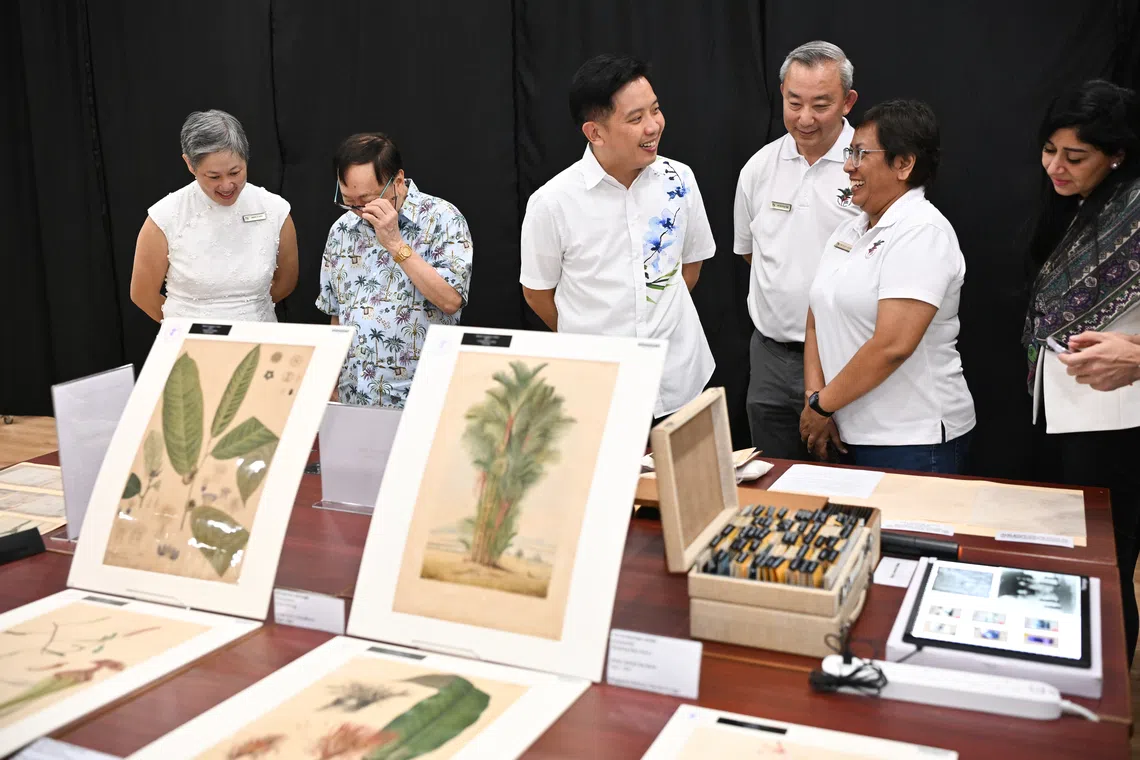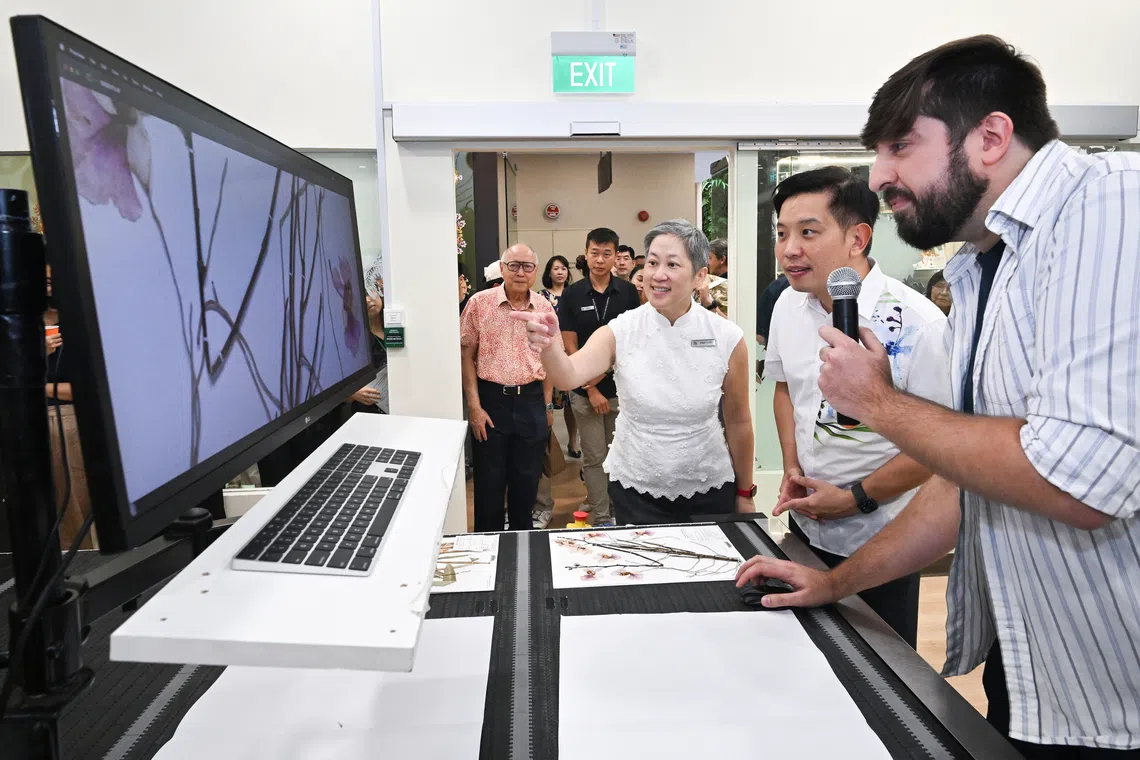Watch the making of S-E Asia’s largest digital plant database at Singapore Botanic Gardens
Sign up now: Get ST's newsletters delivered to your inbox

Minister of State for National Development Alvin Tan (second from left) digitising a Papilionanthe Miss Joaquim (Vanda Miss Joaquim) specimen on Oct 28.
ST PHOTO: LIM YAOHUI
Follow topic:
SINGAPORE – For the first time, the process of preserving plants for posterity can be viewed by the public, following the launch of the Singapore Herbarium’s largest digitalisation effort on Oct 28.
At the Singapore Botanic Gardens, visitors can now watch botanists painstakingly build a digital database of some 800,000 specimens from South-east Asia and beyond.
From a viewing gallery, they can observe the plants being unpacked, barcoded, placed on a conveyor belt and photographed between 9am and 5pm on weekdays.
This is the world’s first public showcase of the process in a working herbarium, the National Parks Board (NParks) said in a statement.
The two-year exercise was launched in conjunction with the 150th anniversary of the herbarium.
The first of its kind in British Malaya, the herbarium was founded by the Botanic Gardens’ former superintendent Henry James Murton in 1875, marking the start of the gardens’ transformation from a pleasure garden to a scientific institution, keeper of the herbarium Jana Leong-Skornickova told The Straits Times.
The digitalisation effort was launched by Minister of State for National Development Alvin Tan, who helped digitise Singapore’s national flower – the Papilionanthe Miss Joaquim – a variety of orchid formerly known as the Vanda Miss Joaquim.
The journey of the herbarium mirrors that of Singapore as a nation, said Mr Tan.
“Like Singapore, it is carefully cultivated over generations, where fragility is transformed into resilience, and where each contribution – no matter how small – adds to collective strength.”
Today, the herbarium houses specimens dating back around 230 years, including cotton, jasmine, blue pea, indigo and tamarind, all collected in Tamil Nadu, India.
When the digitalisation is completed by 2027, the high-resolution images and their data will form the largest online database of plant specimens housed in South-east Asia, enabling research and conservation work, such as identifying species new to science
The bulk of the effort will involve transcribing information from specimen labels, which are often handwritten, said Dr Leong-Skornickova. Scanning technology will be used to speed up the process of digitalising the collection, cutting the imaging time from a decade to just 10 months.
Once concluded, the project will help democratise science and reduce the risk of specimens being damaged – for instance, by being on loan to other countries – she added.
Of the herbarium’s specimens, some 10,000 are type specimens, which are important official representatives of a species that researchers consult when describing plant species new to science.
“A lot of researchers in the region, especially those in biodiverse but not economically well-developed countries, simply have no funds to come to Singapore,” noted Dr Leong-Skornickova.
“Getting this stuff online makes it available for anybody, regardless of income.”

Minister of State for National Development Alvin Tan (third from left) looking at archival materials inside the Singapore Botanic Gardens’ Library of Botany and Horticulture on Oct 28.
ST PHOTO: LIM YAOHUI
NParks said that the database will also allow the Singapore Botanic Gardens’ researchers to pinpoint potential gaps in specimen collection, identify areas for future research of native flora, and examine regional patterns of plant diversity.
The specimens hail from regions such as South-east Asia, New Guinea, East Asia and the South-west Pacific.
To accommodate the gardens’ growing number of specimens, NParks will expand the capacity of the Singapore Herbarium and the neighbouring Library of Botany and Horticulture by about 40 per cent.
When completed, the herbarium will be able to accommodate another 300,000 specimens.
It will also feature better facilities like an expanded drying room and a separate freezing room, while the library will have more storage space.
This will allow the gardens to comfortably store its expanding collection for another 50 years, said Dr Leong-Skornickova, adding that the collection grows by an average of up to 5,000 specimens annually. Expansion works are estimated to end in 2030, NParks said.
Those interested in donating to the digitalisation effort can adopt plant specimens or plant families at this website

The public can observe the digitalisation process in a live viewing gallery, which offers the first-in-the-world showcase of this process in a working herbarium.
ST PHOTO: LIM YAOHUI
Current sponsors include TikTok Singapore, Aramco Singapore and ST Engineering.
Donors who contribute at least $1,000 through a fund-raising campaign named “Herbarium in your Pocket” will receive a limited-edition collectible, with a preserved specimen from the native Tembusu tree featured on Singapore’s $5 note.
Each specimen is collected and mounted by hand by staff, and labelled with a serialised collection number printed with ink drawn from the same tree.
Only 1,000 collectibles will be released in batches, said NParks.
Donations for the collectibles can be made at this website
Visitors to the herbarium can also try out activities in the exhibition “Pressed in Pixels: Digitalising the Singapore Herbarium”.
These include child-friendly activities, ranging from piecing together plant specimens using magnetic plant parts to viewing plant specimens under a magnifying lens to observe their characteristics.
The exhibition runs until August 2026.


